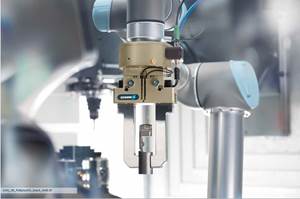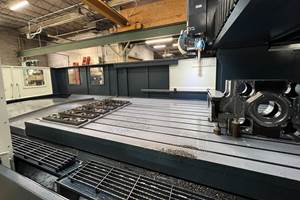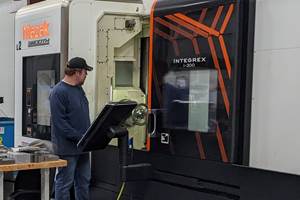How to Overcome an Acc/Dec Limitation in High Speed Machining
A small pocket in a graphite workpiece limits productivity. Part of the expert’s response is to consider how a lower feed rate might actually be more productive—because the machine will spend more time at the programmed rate.
Share






A reader recently used the “Ask an Expert” feature of our High Speed Machining Zone to ask the following question.
Question
We are machining graphite to ±0.0001-inch tolerance on depth, with less than 100RA finish. We are using a machine with 36,000 rpm spindle and 1.7G acc/dec rating. We are machining a 2-inch diameter pocket, contoured in the bottom, with a ballnose tool programmed at 35,000 rpm and 340 ipm. It is a true spiral toolpath, machining in a circular pattern from center to outer diameter. We are not achieving programmed feed rate until we are at about 1.75 inch diameter. The feed rate is varying from 140 ipm in the center progressively faster until it reaches programmed feed at 1.75 inch out. We have reduced the number of points in the program to reduce the lines of code from 36,000 to 4,800 lines, with no change in feed rate that the machine achieves. This done was to prove whether the machine processor not keeping up was the problem. But we noticed no change in feed rate when we reduced the lines of code. Can you steer us in the right direction?
Response from Tom Delio, co-founder of BlueSwarf
Most important in any high speed machining operation is your set up. I am assuming that you are using well-balanced cutters and very concentric cutters. Without a very controlled setup, any other steps you take can easily be compromised.
From there, the main issue appears to be the acc/dec capability of the machine. You are correct that the issue is not with the number of points in the program. It appears your processor is plenty fast enough to handle all the points in the program. The limitation comes from the ability of the axes to accelerate and decelerate within the feature size. At 1.75 inch diameter, each axis has to be traveling fast enough to make a circle/pocket in 1 sec -- which means each axis is traversing back and forth in 1 second, or moving ahead and then back by an amount equal to 1.75 inch minus the cutter diameter in that time.
The possible solutions:
Assuming you are looking for productivity, then the obvious first solution is to attempt to tune the axes better. However, this is not recommended, as the axes are already well-tuned, and any improvement you might achieve will require a trade off or sacrifice (perhaps in overshoot or in surface finish and motion stability).
The next likely solution is to alter your tool path. The spiral tool path might be the most efficient, as it balances out and times the acc/decs of the constitutive axes to minimize dead spots and slow feeds. The best alternative I might suggest is to try to get the longest runs possible to best achieve maximum feed rate for the longest possible time. Perhaps try a zig-zag motion aligned with one of the axes to minimize acc/dec issues, then do a peripheral finishing pass.
Another option depends on whether there is any layered machining. Are you machining to finish in one pass or are there multiple passes being performed? If multiple passes, you could use deeper depths of cut at reduced spindle speed and feed rate. If this is possible, this should increase your average metal removal rate, given that at lower feed rates the acc/dec capability will drive the axes to maximum programmed feed for a longer period.
It is worth noting that at these elevated speeds, vibration is always a concern. Being able to find speeds that minimize vibration is advisable. Once found, then the control of the tool setup is critical to make sure you can repeat the performance.
No matter what your acc/dec capability, there will be a feature size limitation. No machine has the ability to instantaneously reach maximum feed rate. In most of today's controllers, though, computing power has improved to the point that program size is only rarely a limitation.
Related Content
Lean Approach to Automated Machine Tending Delivers Quicker Paths to Success
Almost any shop can automate at least some of its production, even in low-volume, high-mix applications. The key to getting started is finding the simplest solutions that fit your requirements. It helps to work with an automation partner that understands your needs.
Read MoreDN Solutions America Unveils Impressive Chicago Technical Center at IMTS 2024
New tech center is serving as a cutting-edge showroom and a technological hub for advanced machining applications.
Read MoreThree-Axis Bridge Mill Opens New Doors for Construction OEM
Different industries often require different machining priorities, a truism recently demonstrated by Barbco, an OEM of heavy-duty boring equipment that opened up new design possibilities by pivoting toward rigid, less complex machining centers.
Read More5 Tips for Running a Profitable Aerospace Shop
Aerospace machining is a demanding and competitive sector of manufacturing, but this shop demonstrates five ways to find aerospace success.
Read MoreRead Next
Last Chance! 2025 Top Shops Benchmarking Survey Still Open Through April 30
Don’t miss out! 91ÊÓƵÍøÕ¾ÎÛ's Top Shops Benchmarking Survey is still open — but not for long. This is your last chance to a receive free, customized benchmarking report that includes actionable feedback across several shopfloor and business metrics.
Read MoreMachine Shop MBA
Making Chips and 91ÊÓƵÍøÕ¾ÎÛ are teaming up for a new podcast series called Machine Shop MBA—designed to help manufacturers measure their success against the industry’s best. Through the lens of the Top Shops benchmarking program, the series explores the KPIs that set high-performing shops apart, from machine utilization and first-pass yield to employee engagement and revenue per employee.
Read MoreAMRs Are Moving Into Manufacturing: 4 Considerations for Implementation
AMRs can provide a flexible, easy-to-use automation platform so long as manufacturers choose a suitable task and prepare their facilities.
Read More




















